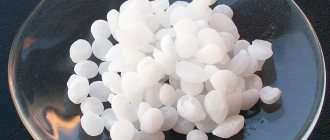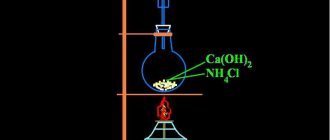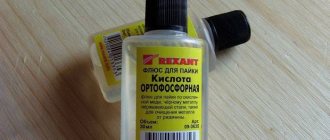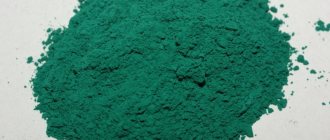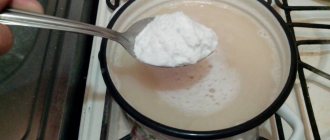Alkalis are water-soluble strong bases. Currently, the Brønsted-Lowry and Lewis theory is accepted in chemistry, which determines acids and bases. According to this theory, acids are substances capable of removing a proton, and bases are capable of donating an electron pair OH−. We can say that bases mean compounds that, when dissociated in water, form only anions of the OH− type. To put it simply, alkalis are compounds consisting of a metal and the hydroxide ion OH−.
Alkalies usually include hydroxides of alkali and alkaline earth metals.
All alkalis are bases, but not vice versa; the definitions “base” and “alkali” cannot be considered synonymous.
The correct chemical name for alkalis is hydroxide (hydroxide), for example, sodium hydroxide, potassium hydroxide. Names that have developed historically are also often used. Due to the fact that alkalis destroy materials of organic origin - leather, fabrics, paper, wood, they are called caustic: for example, caustic soda, caustic barium. However, chemists use the term “caustic alkalis” to define hydroxides of alkali metals - lithium, sodium, potassium, rubidium, cesium.
pH scale
Why are some liquids acids and others alkalis? It turns out that it's all about the type of ions. If the concentration of hydrogen ions in a liquid is higher, such a liquid is an acid, and if there are hydroxide ions, then it is an alkali.
The pH scale is used to measure the acidity or alkalinity of a solution from 0 to 14.
If the pH of a solution is in the range of 0-7, then such a solution is considered acidic, while a solution with pH = 0 is the most acidic. Solutions with a pH in the range of 7-14 are alkalis, while a solution with pH = 14 is considered the most caustic and dangerous.
If the pH of a solution is 7, then such a solution is neutral, since the concentration of hydrogen ions is equal to the concentration of hydroxide ions. An example of a neutral solution is pure water.
What is pH?
Translated from Latin, pH (potentia hydrogeny) means “the power of hydrogen,” i.e. activity of hydrogen ions in aqueous solution.
How do chemists determine the presence of water in a substance?
They take colorless copper sulfate (CuSO4) and add it to the substance. If there is no water, the powder remains colorless, but even with a minimal amount of water it turns blue.
Chemical burn with alkali
When using undiluted alkalis, it is always worth remembering that they are caustic substances that, if they come into contact with open areas of the body, cause redness, itching, burning, swelling, and in severe cases, blisters form. With prolonged contact of such a dangerous composition with the mucous membrane of the organs of vision, blindness may occur.
In case of a chemical burn with alkali, it is necessary to rinse the affected area with water and a very weak solution of acid - citric or acetic. Even a small amount of caustic alkali can cause extensive skin damage and burn mucous membranes, so such substances should be handled carefully and kept away from children.
Use of alkali in our environment
Alkali has found widespread use in our lives. Alkali can provide some form of water softening and remove impurities such as manganese, fluorides and organic tannins. Heavy industries use alkali in the form of lime to absorb and neutralize sulfur oxides in air emissions, thereby reducing the likelihood of acid precipitation. Sulfur dioxide produced by industrial plants and released into the atmosphere returns to the earth in the form of acid rain or sulfuric acid. Such areas exposed to acid rain are treated by aircraft with preparations that contain alkali. This makes it possible to control and neutralize the critical pH level of water and soil in areas where such man-made emissions occurred. Adding alkali to waste and wastewater, maintaining the correct pH level in oxidative processes during their decomposition. Stabilizes sediment formation in wastewater and reduces odor or formation of pathogenic bacteria. Sludge from wastewater bodies treated with quicklime complies with environmental standards, which makes it suitable for further use as fertilizer on agricultural lands.
Industrial applications of alkali
In industrial and mining operations, the use of alkalis in wastewater helps to neutralize harmful compounds and purify them. Treatment with excess alkali increases the pH of the water to 10.5-11 and can disinfect the water and remove heavy metals. Alkalis such as lime are key in the chemical production of calcium carbide, citric acid, petrochemicals and magnesia. In the paper industry, calcium carbonate is a causticizing agent for bleaching. The steel industry depends on lime as a component to remove impurities such as carbon monoxide gas, silicon, manganese and phosphorus.
Detergents formed by alkali
Alkaline detergents help in cleaning heavily soiled surfaces. These economical, water-soluble alkalis with a pH range of 9 to 12.5 can neutralize acids in a variety of types of dirt and deposits.
Alkali in glass and ceramics production
Alkali is the main raw material in glass production. Limestone, as well as sand, soda ash, lime and other chemicals, are fired at extremely high temperatures and turned into a molten mass. Glassblowers and potters use alkalis for glazes and fluxes, which react with acids to form silicates (glass) when heated. Concentrated alkalis create richer color in the glaze.
Literature about alkali
I. Nechaev’s book “Stories about the Elements,” published in 1940, tells in an accessible and understandable language for the average person what alkali is and how it differs from another caustic substance - acid. Excerpt from the text:
“Among the numerous substances that chemists have used in their laboratories since ancient times, caustic alkalis - caustic potassium and caustic soda - have always occupied a place of honor. Hundreds of different chemical reactions are carried out in laboratories, factories and in everyday life with the participation of alkalis. With the help of caustic potassium and soda, for example, most insoluble substances can be made soluble, and the strongest acids and suffocating vapors can, thanks to alkalis, be deprived of all their pungency and toxicity.
Caustic alkalis are very peculiar substances. In appearance, these are whitish, rather hard stones, seemingly unremarkable in anything. But try taking caustic potassium or soda and holding it in your hand. You will feel a slight burning sensation, almost like touching nettles. Holding caustic alkalis in your hand for a long time would be unbearably painful: they can eat away the skin and meat to the bone. That is why they are called “caustic”, in contrast to other, less “evil” alkalis - the well-known soda and potash. By the way, caustic soda and potassium were almost always obtained from soda and potash.
Caustic alkalis have a strong attraction to water. Leave a piece of completely dry caustic potassium or soda in the air. After a short time, liquid will appear on its surface from nowhere, then it will all become wet and loose, and in the end it will spread out into a shapeless mass, like jelly. It is the alkali from the air that attracts water vapor and forms a thick solution with moisture. Whoever has to immerse his fingers in a solution of caustic alkali for the first time declares in surprise: “Like soap!” And this is absolutely correct. Lye is slippery, like soap. Moreover, soap feels “soapy” to the touch because it is made using alkalis. The solution is a caustic alkali and tastes like soap.
But a chemist recognizes caustic alkali not by its taste, but by how this substance behaves with litmus paint and acids. A piece of paper soaked in blue litmus dye instantly turns red when it is dipped into acid; and if you touch the alkali with this reddened piece of paper, it immediately turns blue again. Caustic alkali and acid cannot exist peacefully side by side for even a single second. They immediately enter into a violent reaction, hissing and heating up, and destroy each other until there is not a grain of alkali or a drop of acid left in the solution. Only then does calm come. The alkali and acid “neutralized” each other, they say in such cases. By combining them together, a “neutral” salt is obtained - neither sour nor caustic. So, for example, from the combination of hot hydrochloric acid with caustic soda, ordinary table salt is obtained.”
Distinctive features of alkali.
From what we have read above, we already know that the opposite of alkali is acid. Instead of the bitter taste inherent in alkalis, acids tend to taste sour. An example would be foods such as lemons or fruit vinegar (diluted), which are inherently acidic foods and contain acid in their composition. We can determine whether a substance is alkali or acid by knowing its pH. pH levels are measured using a pH scale; this scale ranges from 0-14, and these numbers tell us whether a substance is an alkali or an acid. Pure distilled water has a pH level of 7 and is called neutral (right in the middle of the scale). Any substance that has a pH above 7 is an alkaline substance, which may also be called an alkali. And, any other substance that has a pH below 7 is an acid.
Why is the substance alkaline?
So we already know that the pH level is a scale whose values range from 0-14 and indicate whether a substance is alkaline or acidic. However, we don't really know why. Let's look at this issue in more detail.
The pH level of a substance depends on how the atoms are arranged and combined in the substance. Pure water sits right in the middle of the scale and has a pH of 7. This means it contains equal amounts of hydrogen atoms (H+) and hydroxide atoms (OH-). When a substance has more hydrogen atoms (H+), it is an acid. When a substance has more hydroxide atoms (OH-), it is alkaline.
Where to buy lye?
You can buy alkali in Novosibirsk with a purity grade of analytical grade (pure for analysis) in the “For Business” store on the orders page: caustic soda NaOH or caustic potassium KOH. For non-resident buyers, goods can be sent by Russian Post or transport companies.
Copyright
The rights to this article belong to the site administrator: Konstantin Vladimirovich Farafonov. To confirm copyright, a procedure was carried out to deposit the materials of the published content. Any copying of materials from this article is not permitted without the written consent of the copyright holder. The estimated value of the page content is set at $100. A person who has made an unauthorized partial or complete copy of the materials presented on the page and subsequently posted them on third-party Internet resources expresses his agreement to pay the copyright holder five times the estimated value of the stolen content. If you wish to use materials from our site, please contact us.
What is an acid?
Acids are molecules that, when dissolved in water, release a hydrogen ion. Ions are positively and negatively charged particles that give acids their properties.
Hydrochloric acid molecule
Let's look at this process using the example of hydrochloric acid - HCI. If hydrochloric acid is combined with water, it will break down into a hydrogen ion (H+) and a chloride ion (CI). Since the water molecule also contains hydrogen, when hydrochloric acid decomposes, the total number of hydrogen ions in the solution will increase.
What happens to alkalis when they get into water? In water, alkalis release hydroxide ions. For example, sodium hydroxide (NaOH) is an alkali. When combined with water, it breaks down into sodium ions (Na+) and hydroxide ions (OH). When hydroxide ions meet hydrogen ions in water, the total number of hydrogen ions in the solution is reduced.
Interaction with indicators
To determine the pH of the test solution, special chemicals are used - indicators that change their color depending on the value of the hydrogen index in the medium. The most common indicator used in chemical research is litmus. In an alkaline environment it will take on an intense blue color.
Another available indicator, phenolphthalein, takes on a crimson color in an alkaline environment. However, in a very concentrated solution (hydrogen index is close to 14), phenolphthalein remains colorless, as in a neutral environment. Therefore, it is preferable to use litmus when working with concentrated alkalis.
The methyl orange indicator becomes yellow in an alkaline medium; as the pH of the medium decreases, the color changes from yellow to orange and red.
A few historical moments from the history of alkali production.
People have been using alkali for centuries, obtaining it first from leaching (aqueous solutions) of certain desert lands. Until the late 18th century, leaching from wood ash or seaweed was the main source of alkalis. In 1775, the French Academy of Sciences offered cash prizes for new methods of producing alkalis. The soda ash prize was awarded to the Frenchman Nicolas Leblanc, who in 1791 patented a process for converting sodium chloride to sodium carbonate.
The Leblanc method of production dominated world production until the end of the 19th century, but after the First World War it was completely replaced by another method of salt conversion, which was improved in the 1860s by Ernest Solvay of Belgium. At the end of the 19th century, electrolytic methods for the production of caustic soda appeared, the volumes of which grew rapidly.
According to the Solvay method, the ammonia-soda process for the production of soda ash proceeded as follows: table salt in the form of a strong brine was chemically treated to eliminate calcium and magnesium impurities and then saturated with recirculating ammonia gas in towers. The ammonia brine was then gassed using carbon dioxide gas at moderate pressure in another type of tower. These two processes produce ammonium bicarbonate and sodium chloride, the double decomposition of which produces the desired sodium bicarbonate as well as ammonium chloride. The sodium bicarbonate is then heated until it decomposes into the desired sodium carbonate. The ammonia involved in the process is almost completely reduced by treatment with ammonium chloride and lime to produce ammonia and calcium chloride. The recovered ammonia is then reused in the processes described above.
The electrolytic production of caustic soda involves the electrolysis of a strong saline solution in an electrolytic cell. (Electrolysis is the breaking down of a compound in solution into its constituents using an electric current to produce a chemical change.) Electrolysis of sodium chloride produces chlorine, sodium hydroxide, or sodium metal. Sodium hydroxide in some cases competes with sodium carbonate in the same application processes. And in any case, both are interconvertible through fairly simple processes. Sodium chloride can be
converted into an alkali by one of two processes, the difference between them being only that the ammonia-soda reaction process produces chlorine in the form of calcium chloride, a compound of little economic importance, while electrolytic processes produce elemental chlorine, which has innumerable uses in chemistry industry.
Several places in the world have significant reserves of a mineral form of soda ash known as natural alkali. Such deposits produce most of the world's natural alkali from vast deposits in underground mines.
Natural sodium metal.
Read the article Alkali (source: Chemist's Encyclopedic Dictionary) and get a better idea of what alkali is, or watch a video about this chemical reagent Alkali.
What is a foundation?
A base is a compound that is the chemical opposite of an acid. The base contains metal ions and associated hydroxide ions. These substances are capable of attaching hydrogen ions (H+) from the acid. When a base is mixed with an acid, it completely neutralizes its properties, and the reaction produces a salt.
For example, from a chemical point of view, the toothpaste you are familiar with is a base that neutralizes the acid remaining in the mouth after eating.
REMEMBER! Due to the fact that ions exist only in solutions, acids also exhibit their properties only in solutions.
Classification
The grounds are divided according to the following criteria:
Solubility in water:
- soluble – hydroxides of alkali and alkaline earth metals, heavy metal thallium(I) TlOH, as well as ammonium hydroxide;
- insoluble.
Acidity is the number n of hydroxide ions OH- connected to the metal: one-, two-, three-acid.
Strength is the ability to dissociate, that is, release hydroxide ions:
- strong (all soluble, with the exception of ammonium hydroxide, and slightly soluble hydroxides of the alkaline earth metals calcium Ca(OH2) and strontium Sr(OH2);
- weak (water-insoluble bases and ammonium hydroxide NH4OH).
Alkalis
Alkalies include strong bases that are soluble in water. In relation to calcium and strontium hydroxides, the term "alkali" applies to the dissolved part:
The formula of an alkali has the form ROH or ROH2, depending on the degree of oxidation of the metal that forms it R. There are no tribasic alkalis. The table shows alkalis formed by metals of different groups of the periodic table:
| Metals | Hydroxides |
Alkaline (IA):
| "Caustic alkalis": LiOH NaOH KOH RbOH CsOH |
Alkaline earth (II A):
| Ca(OH2) Sr(OH2) Ba(OH2) Ra(OH2) |
III A:
| TlOH |
The larger the radius of the metal cation and the lower its charge (oxidation state), the weaker the bond with the OH- hydroxyl group and, therefore, the stronger the base. The strongest alkalis in chemistry are cesium and radium hydroxides: these metals have the largest ions. Accordingly, the weakest of the alkalis is lithium hydroxide.
Application of alkalis
- As electrolytes. — For the production of fertilizers. — In medicine, chemical, cosmetic production. — In fish farming for sterilization of ponds.
In the Prime Chemicals Group store you will find the most popular alkalis at competitive prices.
Sodium hydroxide
The most popular and in demand alkali in the world.
It is used for saponification of fats in the production of cosmetics and detergents, for the production of oils during oil refining, as a catalyst and reagent in chemical reactions; in the food industry.
Caustic potassium
It is used for the production of soap, potash fertilizers, electrolytes for batteries and accumulators, and synthetic rubber. Also - as a food additive; for professional cleaning of stainless steel products.
Aluminum hydroxide
Demanded in medicine as an excellent adsorbent, antacid, enveloping agent; vaccine ingredient in pharmaceuticals. In addition, the substance is used in wastewater treatment plants and in processes for producing pure aluminum.
Calcium hydroxide
A popular alkali with a very wide range of applications, which is known in everyday life as “slaked lime”. Used for disinfection, water softening, in the production of fertilizers, caustic soda, bleach, and building materials. Used to protect trees and wooden structures from pests and fire; in the food industry as a food additive and reagent in the production of sugar.
Lithium hydroxide
A sought-after compound in the chemical industry as a raw material; in the glass, ceramics, radio engineering industries; for the production of lubricants, electrolytes; to absorb harmful gases.

